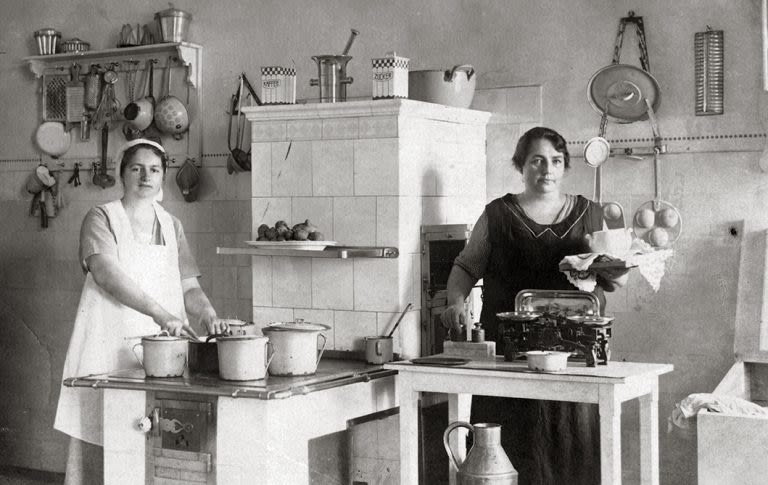Have you ever wondered how aprons became the symbol of cooking and hospitality?
In this comprehensive guide, we explore the history of aprons and their role in different professions – from baristas to surgeons. Discover the story behind these garments and better understand why they are essential for certain jobs.
So come along on a journey through the history of aprons!
The apron is one of the oldest garments in human history. Aprons were used by craftsmen, soldiers, and chefs alike to protect clothing from dirt and debris and remain an essential tool in many industries today. The name apron comes from the French word ‘naperon’ which means “little napkin”. Traditionally, aprons were made of heavy fabrics that were designed to last and withstand abuse while providing form fitting coverage.
Throughout the ages aprons served multiple purposes from protecting clothing from dirt and grime to helping people manage multiple tasks at once by having their tools close at hand via pockets or straps attached to the apron. Aprons also proved useful for decoration, as is seen in their use in Britain during much of the 16th century where sections of brightly colored cloth were added to plain black gowns as a way for women express their stature, taste and wealth.
Today aprons can still be seen being worn within many professions ranging from being worn by brewers to surgeons. This article will explore why aprons are still used today within different professions along with looking at the types of aprons available on the market today.
Definition of aprons
Aprons are protective garments typically worn over the torso and front of the legs. Traditionally integrated into work clothes, they are usually made of cloth or leather, sometimes with metal or plastic bibs. Aprons have been used in various industries since medieval times, although their origin and usage vary depending on the region and profession.
The term apron is derived from the Middle English word “naperon,” which was borrowed from Old French naperon meaning small tablecloths or napkins. Aprons were initially designed to protect clothing from household messes such as dirt and stains caused by cooking and cleaning-related activities; however, aprons have become suitable for casual fashion trends as well as various professions.
Across various cultures, aprons continue to be used for a variety of purposes. In modern times, aprons serve both practical functions in certain professions (e.g., healthcare workers) and novelty purposes for fashion enthusiasts. As generations pass down special techniques for making aprons, people around the world use them as symbols of social status or simply to express unique personal styles and interests.

Brief overview of the history of aprons
The use of aprons has a long and varied history and they have been used in many different professions. In early Europe, particularly in the Middle Ages and Renaissance ages, aprons were predominantly used by servants and lower classes as a badge of their positions. As trade guilds became more powerful, members began to mark themselves with special livery or insignia in the form of an apron. These unique embellishments soon identified members of each profession ranging from leather workers, chefs, butchers, masons and merchants.
Aprons were also popular during colonial times when women kept multiple aprons handy for various kinds of chores around the house from washing dishes to baking bread. In recent years wearing an apron has become synonymous with chefs and waiters. Aprons provide both protection from accidental spills as well as stylish garb for waitstaff or kitchen staff in restaurants, catering companies and hotels.
History of Aprons
Aprons have been used for hundreds of years in varying societies, however, there is little consensus on their history and where exactly they originated. It is known that aprons are closely related to the garments of the Ancient Egyptians, Greeks, and Romans.
17th-century paintings depict a variety of European populations wearing aprons, with some believed to be originating around that time in Spain and Italy. This type of apron was known as a tabard or cope; it was long-sleeved and fitted closely at the chest to protect from dirt or splashes from food or liquids.
Apron use only increased in popularity during the Industrial Revolution as industrialized nations used them more extensively across occupations. Barbers started using them to protect their clothing while cutting hair; butchers began sporting them as well for both protection against sudden splashes and also to give them an authoritative presence with customers; bakers adopted the dress part of it as well to shield their clothing while messing with flour and other ingredients; doctors too began using surgical isolation gowns which are basically gowns designed to substitute an apron while protecting from bacteria. Aprons can still commonly be seen today throughout all sorts of businesses including waiters at restaurants who use it mostly for aesthetic purposes rather than practicalities.
Early history of aprons
Aprons have been around for centuries and can trace their roots back to the ancient Sumerian civilization. This civilization existed in Mesopotamia (located in present-day Iraq and Kuwait) between 5000 and 4000 BC, and evidence suggests that aprons were already a part of regular attire by 3000 BC. From this point forward, aprons have been found to be a part of dress worn by many different cultures worldwide.
The earliest aprons had religious significance, with the ancient Greeks creating special garbs adorned with jewels or other decorative elements as a sign of their faith. The Roman Empire also used aprons, which developed into more elaborate garments during the Renaissance era when they began to incorporate different fabrics and intricate designs. As the eighteenth century arrived in Europe, aprons started becoming more practical with workwear versions made from cotton gingham fabric being worn for housekeeping duties.
In the United States dating back to 1650, aprons were often plain pieces of cloth either hung from belts or fastened at the neck and waist using straps or cords. By mid-nineteenth century it was considered fashionable wear for women which is still true today! The 1920s saw a resurgence of interest in this garment’s fashion potential as midi-dresses came into vogue – a trend that continues even today.
Evolution of apron styles
The style of apron has gone through many different transformations through the ages and this evolution has been shaped largely by its use in different professions. Aprons were essential in industrial times when protecting one’s clothing from dirt, grime, and other dangers was paramount. In more recent times, the apron has been adapted to be more fashionable or functional depending on the type of job it will be used for.
In the past, cotton was used as the material of choice for aprons and they could often be ornate in design. Embroidery became popular with domestic staff in well-to-do houses and these would usually feature a large pocket at the front for practicality. Longer aprons have often been seen with chefs especially over the last few decades and are designed to express individual personalities while still affording protection from splashes. For nursing staff modern lightweight fabric is much preferred as they often need to stay comfortable throughout their day-to-day duties.
For everyday casual use, denim is becoming popular as it can be dressed up with studs or lace for added flair. Women have also been known to wear bright colored aprons when hosting parties or barbecues due to its timeless style which never goes out of fashion. Aprons can come in all shapes such as half-aprons which are shorter than traditional styles making them more suitable for everyday use especially if paired with a dress or top that covers the midriff area.
Aprons in Different Professions
Throughout history, aprons have been used by workers in many professions and industries to protect their clothing from dirt and debris. From butchers and bakers to craftspeople and chefs, aprons have been essential clothing for those in the service industry.
Butchers: Butchers have traditionally worn protective aprons that cover both their front and back sides to protect them not only from dirt, but also from blood that results from cutting meat. Historically, butcher’s aprons were made of thick leather and usually feature one large pocket across the chest area where they’ll store a knife or two as they go about their tasks.
Bakers: Bakers usually wear lighter-weight fabric aprons while handling dough and other baking ingredients. The apron helps wine spills, splatters of flour, sugar, or butter off the baker’s clothes during the baking process. Aprons specifically designed for bakers often contain several pockets along the bottom half for holding essential tools such as rolling pins, dough whisks, or baguette blades.
Craftspeople: Woodworkers typically wear heavy-duty leather aprons to protect themselves from sawdust and woodchips that fly up off the saw blade during woodworking processes such as cutting or planing. Leather is a durable material choice for workshop activities such as carpentry work due to its resistant properties against water, heat sources such as hot tools and sparks off welding machines.
Chefs: Professional chefs often don heavy-duty fabric or vinyl aprons while in the kitchen – thicker materials like these can protect them from hot oil spills or sharp objects when preparing meals. Some professional chefs may even wear long-sleeved shirts underneath their traditional white cooking coats in order to further protect themselves from burns or cuts when on duty.

Culinary industry
In the culinary industry, aprons are a part of the uniform for chefs, wait staff, and other personnel. The history of aprons in the culinary industry began during the Middle Ages with bakers’ aprons. Bakers wore longer aprons to cover their clothes while they kneaded bread dough or worked around hot ingredients and ovens. By the 1800s, kitchen workers started wearing shorter, plain white cotton aprons. This shift was attributed to the invention of more practical clothing such as smocks and tunics that didn’t require large pieces of fabric to cover them.
Today, chefs wear sturdy white cotton twill or canvas in hard-wearing designs that provide protection from spills and heat. Cross-back styles offer both comfort and a snug fit; wrap-around styles that tie at an adjustable waist give similar coverage but with greater mobility. For a touch of elegance, chefs use monogrammed embroidered neck aprons with traditional cotton twill or richly dyed herringbone fabric for an upscale image appropriate in fine dining restaurants or on television shows. Wait staff generally wear server’s half aprons made of lightweight fabrics like spun polyester for comfort and quick cleaning when guests leave spills behind at their tables.
Types of aprons worn by chefs and cooks
Chefs and cooks often use aprons to protect their clothing while they are preparing food. Aprons come in a variety of sizes and styles depending upon the specific profession and use.
The three main types of aprons worn by chefs and cooks are the bib apron, the waist apron, and the full-length butcher apron:
Bib Apron: A bib apron is often chosen for its versatility as it may be used for every type of kitchen chore. This apron features straps which go over the shoulders with a top flap that comes up over one’s chest area.
Waist Apron: A waist apron may be used for tasks involving shorter amounts of time, and feature an adjustable belt or ties around one’s waist which facilitates quick removal when needed. Waist aprons are typically plain-colored with no pockets or embellishments, making them perfect for front-of-house roles where cleanliness is paramount.
Butcher Apron: The classic butcher’s apron is full length and ties at the back, making it difficult to remove quickly while on the job. The full-length reach helps protect chefs’ clothing from potentially hazardous liquids such as boiling oil or hot soup splatter — an excellent option when more protection is needed in intense kitchen environments.
Role of aprons in culinary professions
Aprons have always been useful for protection in many different professions, but the culinary world is one of the most well-known fields where aprons are seen. Chefs, cooks and bakers all use aprons to protect their clothing from spills and avoid contamination. Historically, chefs were some of the first professionals to wear themed garments in an effort to differentiate them from other tradespeople.
Chef’s aprons were originally quite long and often tied at the waist with intricate sashes and bows. Some versions went down to the ground and featured fancy fabrics such as velvet or heavy cotton embroidered with ornate designs. As the profession began to be taken more seriously, unisex garments made of lightweight materials became popular — those are still seen today with a host of unique designs that reflect both traditionalism and modernity in cooking styles.
Aprons are also widely used by servers or waiters in restaurants. For most culinary establishments, a standard uniform includes an apron that emphasizes cleanliness while protecting service staff’s own clothing during long shifts. Waiters typically wear shorter garments split at both sides for additional mobility when taking orders or delivering food and drinks tableside. Short sleeve versions are used during summer months when heat can become overwhelming inside busy kitchens or dining rooms — but regardless of the length or style worn by service personnel, it’s an essential part of any uniform that demands attention to detail for eatery patrons as well as professionalism amongst wait staff members alike.
Contemporary Apron Designs
As contemporary fashion trends began to take hold, a variety of apron styles emerged. From butchers’ aprons and bibs, to chefs’ tops and full-length smocks, the modern apron has become much more than a utilitarian piece of clothing. Here is an overview of the various contemporary designs seen in today’s kitchens, restaurants and health care facilities:
Butchers’ Aprons – Also known as bib aprons or waist aprons, these are designed for protection from splashes during food preparation and have a modest ‘V’ cut that flares out at the waist to allow for ease of movement. They often come with multiple pockets for knives or utensils.
Chefs’ Tops – These short jackets are designed to conceal chefs’ clothing while they work in the kitchen. They are buttoned up at the chest and often feature slits at the side seams so that they can be easily taken off when not needed.
Full-length Smocks– These traditional garments feature long sleeves and collars that cover the wearer’s neck and chest areas. They typically come in white cotton or other lightweight fabrics with snap closures on the front and sometimes include pockets in which an item such as a pen can be stored.
Medical Gowns – Medical gowns are specific types of full-length smocks used by medical professionals such as nurses, doctors, dentists etc., to protect themselves from bodily fluid exposure when attending to patients during treatments or procedures. They usually come in white or light blue fabrics with snap closures at the back for ease of donning/doffing and may include safety straps for improved personal protection against hazardous materials.
Modern apron materials
Modern aprons can be made from a variety of materials, depending on the job or occasion. Many modern aprons are made from cloths like cotton, linen, and synthetic fibers. These cloths can be tailored for a specific fit and come in a variety of styles for both men and women. Denim is frequently used for its durability and resistance to staining. Leather is also sometimes used, particularly in the catering and restaurant industry.
In recent years, designers have been experimenting with other unusual apron materials such as clear plastic overalls, rubber aprons that can be slipped on over clothing to protect it while preparing food or working in other messier activities. In addition to traditional monochrome fabrics there are now bright coloured classic prints as well as vintage designs that add a touch of style to every task you undertake.
Contemporary apron styles and designs
In the past decade, apron trends have changed significantly as contemporary apparel has become fashionable and stylish. Today, aprons come in a variety of styles and designs to suit different preferences and purposes.
The modern apron often features bold colors, prints or patterns as well as less typical textures such as denim or corduroy. Many incorporate pockets both practical and decorative. Aprons now also feature closures with adjustable straps so that they can fit a range of body sizes, from petite to plus-size. These modern aprons might be shorter to provide more freedom of movement for those who are working standing up for extended periods of time. Even the traditional waist-length style often has some stylish additions like ties with pretty details or bright colors for a fun look that can still be considered professional attire regardless of profession.
Another trend when it comes to aprons is “the tank top” style that wraps around the torso without extending into the lower half of the body, perfect for restaurant hosts, servers, chefs and food professionals who need comfort while they move around quickly during their workday shift or busy service environment. And speaking of chefs, because they go through such rigorous tasks while they work on food preparation so often we see them with thicker cloth designs made to protect against heat spills and stains better than other aprons available on the market today.

Conclusion
In conclusion, although aprons first began as garments for practical use, they have since become much more than a utilitarian item of clothing. Beyond their traditional roles in the kitchen and manufacturing industry, aprons are also commonly worn by service providers in hospitality and medical professions. Nowadays, aprons not only serve a functional purpose but often serve to reflect a pride in one’s profession or craft.
The history of aprons is intertwined with those of the changing times, technology, and societal norms. Despite their many uses over the years, they remain an essential part of daily life that continues to evolve with current fashion trends and modern tastes.
FAQ’s
What are the different types of aprons in history?
There are various types of aprons in history, including bib aprons, pinafore aprons, waist aprons, cobbler aprons, and many more.
What professions use aprons?
Aprons are commonly used by professionals in industries such as cooking, baking, gardening, woodworking, metalworking, and science.
What is the history and meaning of the apron?
The history of the apron dates back to ancient times when they were worn by laborers and craftsmen. The meaning of the apron has evolved over time, and it can symbolize various things such as protection, modesty, and professionalism.
What is the use and importance of apron?
The use of aprons is to protect clothing from getting dirty or damaged during work. The importance of aprons is to ensure hygiene, safety, and professionalism in various professions.
What is the importance of apron in medicine?
In medicine, aprons are used to protect healthcare workers from contamination and infection. They are an essential part of personal protective equipment (PPE) and play a vital role in preventing the spread of diseases.
What are the unique features of apron?
The unique features of aprons depend on the type of apron. However, some common features include adjustable straps, pockets, water resistance, and durability.
How many types of aprons are there?
There are various types of aprons, and the exact number can be subjective. However, some of the most popular types include bib aprons, pinafore aprons, waist aprons, cobbler aprons, and bistro aprons.
What is a fun fact about apron?
In the 16th century, aprons were considered a sign of wealth and social status. They were often decorated with expensive fabrics, lace, and embroidery.
What is the introduction of apron?
The exact introduction of aprons is unknown, but they have been used for centuries in various cultures and professions. They were initially worn as a practical garment to protect clothing during work.
Who wrote the history of aprons?
There is no specific author of the history of aprons. However, there are various books, articles, and documentaries that discuss the history and significance of aprons.
See more-
- Best aprons 2023
- Best artist aprons 2023
- Best bbq aprons 2023
- Best cooking aprons for guys 2023
- Best hair stylist aprons 2023

Douglas Keefer is the CEO and author of apronspalace.com and Informative Website. With his extensive knowledge and expertise in the world of aprons, he has helped thousands of people find the perfect apron for their needs. Douglas’s commitment to transparency and honesty has made apronspalace.com stand out in a sea of biased reviews and sponsored content. He is a true pioneer in the world of aprons and a passionate advocate for the culinary arts


